2017 Gulf Guardian Award Winners
On This Page:
About the Gulf Guardian Awards
About the Gulf Guardian Awards
The Gulf of Mexico Program Partnership developed the Gulf Guardian awards as a way to recognize and honor the businesses, community groups, individuals, and agencies that are taking positive steps to keep the Gulf healthy, beautiful and productive. The Gulf Guardian Award exemplifies what the Gulf of Mexico Program is all about: innovative solutions that come about when we pool resources and look for creative ways to positively impact our quality of life and economic well-being.
The first Gulf Guardian Award winners were recognized in 2000. Every year since, a first, second and third place award are given in seven categories:
- Business/Industry
- Civic/Non-Profit Organization
- Partnerships
- Youth Environmental Education
- Individual
- Environmental Justice/Cultural Diversity
- Bi-National
Since 2009, the Gulf Guardian awards are recognized on a biannual basis.
First Place Gulf Guardian Winners
First Place Gulf Guardian Winners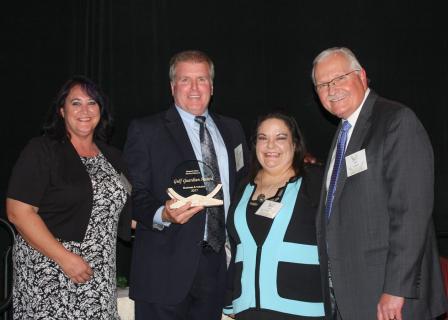 Pictured from left to right include: Donna Simms, Marketing Coordinator at Booyah Clean; Michael Wisecarver, President at Booyah Clean; Ligia Hernandez, Chemist R&D at Booyah Clean; Bill Honker, EPA Region 6 Water Division Director.
Pictured from left to right include: Donna Simms, Marketing Coordinator at Booyah Clean; Michael Wisecarver, President at Booyah Clean; Ligia Hernandez, Chemist R&D at Booyah Clean; Bill Honker, EPA Region 6 Water Division Director.
1st Place Business & Industry
Booyah Clean Marine Cleaners
Booyah Clean, LLC
Harahan, Louisiana
https://youtu.be/-bYtQOySmAk
Booyah Clean is an award-winning line of marine cleaning products that are safer for human health and the environment, as designated by EPA’s Safer Choice program. Booyah Clean Products give consumers an alternative to conventional marine cleaners which may contain toxic chemicals and that should not be released directly into the environment. The innovation within Booyah Clean stems both from the breakthrough patent-pending formula that provides a healthy environment for aquatic life and the revolutionary creative process behind the conception of the products.
1st Place Youth Environmental Education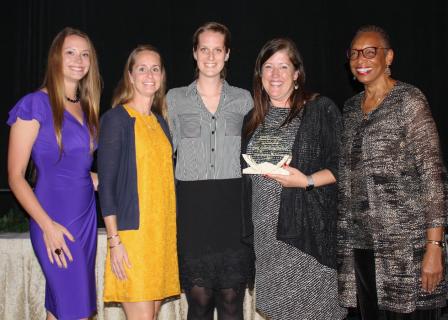 Pictured from left to right include: Sabrina DiNella, Coordinator; Tristin Ware, Senior Education Manager at The Florida Aquarium; Katie Fortescue, Education Coordinator at the Florida Aquarium; Debbi Stone, Vice President of Education at The Florida Aquarium; Anne Heard, EPA Region 4 Deputy Regional Administrator.
Pictured from left to right include: Sabrina DiNella, Coordinator; Tristin Ware, Senior Education Manager at The Florida Aquarium; Katie Fortescue, Education Coordinator at the Florida Aquarium; Debbi Stone, Vice President of Education at The Florida Aquarium; Anne Heard, EPA Region 4 Deputy Regional Administrator.
Watershed Investigations: Engaging Underserved Youth
The Florida Aquarium
Tampa, Florida
https://youtu.be/fQ9h-ua13Ro
Watershed Investigations (WI) enables underserved students to experience their watershed while conducting scientific investigations. Components include exploring issues, learning and practicing field techniques, collecting data, and analyzing results with teachers and peers. During the lifespan of the project, WI impacted ~ 2,640 students and 80 teachers.
1st Place Environmental Justice/Cultural Diversity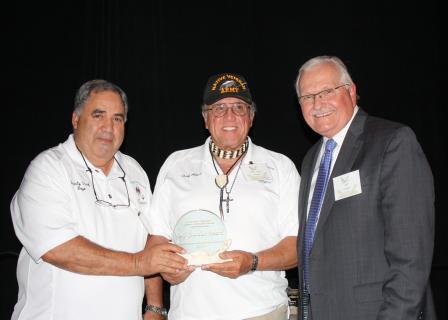 Pictured from left to right include: Deputy Chief Boyo Billiott; Chief Albert Naquin; Bill Honker, EPA Region 6 Water Division Director.
Pictured from left to right include: Deputy Chief Boyo Billiott; Chief Albert Naquin; Bill Honker, EPA Region 6 Water Division Director.
Isle de Jean Charles Band of Biloxi-Chitimacha-Choctaw Tribal Resettlement
Isle de Jean Charles Band of Biloxi-Chitimacha-Choctaw
Houma, Louisiana
https://youtu.be/OKJlyE_uIAU
The Isle de Jean Charles Band of Biloxi-Chitimacha-Choctaw is in the process of resettling their community further inland as a result of tremendous land loss. Once completed, the resettlement will bring together the now-scattered tribal population while also restoring the ecosystem at the new site.
The goal of the resettlement is to maintain and strengthen the tribe’s safety, collective identity, social stability, and contribution to the region. Traditional ways of life will be rekindled and reinforced with tribal members living in one community.
1st Place Civic/Non-Profit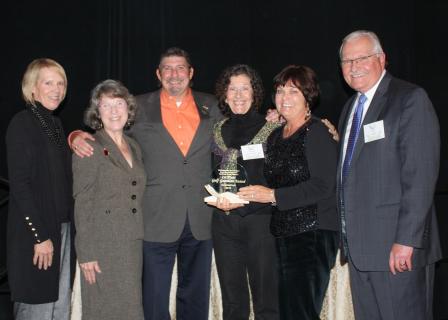 Pictured from left to right include: Sandy Parker, Chapter Member at Galveston Bay Area Texas Master Naturalist; Julie Massey, Sponsor; George Kyame, President at Galveston Bay Area Texas Master Naturalist; Stennie Meadours, Chapter Member at Galveston Bay Area Texas Master Naturalist; Maureen Nolan-Wilde, Past President at Galveston Bay Area Texas Master Naturalist; Bill Honker, EPA Region 6 Water Division Director.
Pictured from left to right include: Sandy Parker, Chapter Member at Galveston Bay Area Texas Master Naturalist; Julie Massey, Sponsor; George Kyame, President at Galveston Bay Area Texas Master Naturalist; Stennie Meadours, Chapter Member at Galveston Bay Area Texas Master Naturalist; Maureen Nolan-Wilde, Past President at Galveston Bay Area Texas Master Naturalist; Bill Honker, EPA Region 6 Water Division Director.
Galveston Bay Area Chapter-Texas Master Naturalist Confront Plastic Pollution
Galveston Bay Area Chapter – Texas Master Naturalist
La Marque, Texas
https://youtu.be/ksNUhzVybiY
Galveston Bay Area Chapter (GBAC) members have monitored nesting sea turtles and shore birds for the last several years. Noticing increasing numbers of birds harmed or killed due to plastic litter, members realized plastic pollution needed to be removed and other organizations and the public needed to be learn about the harm plastic litter was doing.
In January 2016, the chapter committed to conducting cleanups and included plastic pollution education in all outreach activities. They held 12 cleanup events throughout the Galveston Bay area. removing over 3,500 pounds of plastic. They also hosted 178 education events with direct contact to 3,250 community participants, which promoted awareness and shift behavior to promote proper disposal of plastic.
1st Place Individual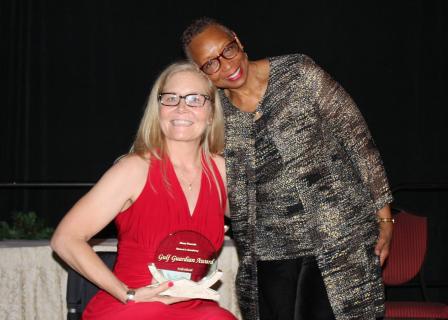 Pictured from left to right include: Dana Pounds, Executive Director, Nature’s Academy; Anne Heard, EPA Region 4 Deputy Regional Administrator.
Pictured from left to right include: Dana Pounds, Executive Director, Nature’s Academy; Anne Heard, EPA Region 4 Deputy Regional Administrator.
Dana Pounds
Nature’s Academy
Bradenton, Florida
https://youtu.be/7kby9VF2fgI
Since founding Nature’s Academy in 2007, Dana has impacted over 50,000 students from 41 states and 4 countries. A true advocate of educational equity, Dana offers programs to underserved students at no cost to their families or schools. In 2016, every 5th grader within Manatee County School District attended a Nature’s Academy “edventure”. She inspires and empowers students to become environmental stewards of the Florida Gulf Coast, creating a legacy that will endure for generations.
1st Place Bi-National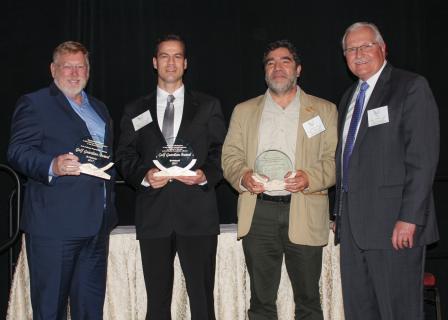 Pictured from left to right include: Dr. Quenton Dokken, President and CEO Gulf of Mexico Foundation; Eric Gustafson, Co-founder and Executive Director of Gulf of Mexico Foundation – Mexico Chapter; Dr. Cuauhtemoc Leon, Co-founder and Technical Director of the Gulf of Mexico Foundation – Mexico Chapter; Bill Honker, EPA Region 6 Water Division Director.
Pictured from left to right include: Dr. Quenton Dokken, President and CEO Gulf of Mexico Foundation; Eric Gustafson, Co-founder and Executive Director of Gulf of Mexico Foundation – Mexico Chapter; Dr. Cuauhtemoc Leon, Co-founder and Technical Director of the Gulf of Mexico Foundation – Mexico Chapter; Bill Honker, EPA Region 6 Water Division Director.
Mangrove Restoration in Key Mexican Coastal Lagoons at the Gulf of Mexico
Gulf of Mexico Foundation Mexico Chapter
Mexico
https://youtu.be/OG9wgAIpArM
The Gulf of Mexico Foundation Mexico Chapter works to raise public awareness of wetlands and coastal habitats while working to conserve and restore these ecosystems. During 2015, the Mexico Chapter carried out a major project to restore mangroves in coastal lagoons in the Mexican Gulf States of Veracruz, Campeche and Quintana Roo. Working with unique conditions and threats at each site, the group restored almost 82 acres of mangroves, which benefitted an additional 370 acres of habitat. The restoration of coastal lagoons and mangroves will help reestablish habitats that sustain a wide variety of plants and animals, nourishing coastal fisheries and supporting complex food webs.
1st Place Partnerships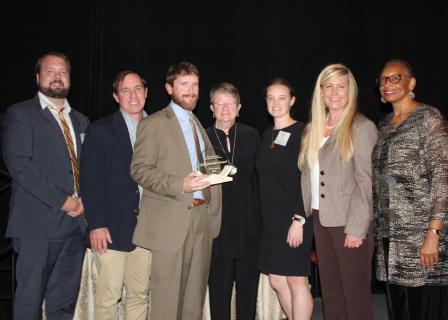 Pictured from left to right include: Harron Wise, Fisheries Scientist at Mississippi Department of Marine Resources; John Anderson, Gulf Coast Research Laboratory; Rick Burris, Shrimp & Crab Bureau Director at the Mississippi Department of Marine Resources; Harriet Perry, Senior Research Scientist at the Gulf Coast Research Laboratory; Darcie Graham, Graduate Program & Grants Coordinator at the Gulf Coast Research Laboratory; Traci Floyd, Deputy Director at the Mississippi Department of Marine Resources; and Anne Heard, EPA Region 4 Deputy Regional Administrator
Pictured from left to right include: Harron Wise, Fisheries Scientist at Mississippi Department of Marine Resources; John Anderson, Gulf Coast Research Laboratory; Rick Burris, Shrimp & Crab Bureau Director at the Mississippi Department of Marine Resources; Harriet Perry, Senior Research Scientist at the Gulf Coast Research Laboratory; Darcie Graham, Graduate Program & Grants Coordinator at the Gulf Coast Research Laboratory; Traci Floyd, Deputy Director at the Mississippi Department of Marine Resources; and Anne Heard, EPA Region 4 Deputy Regional Administrator
Mississippi Derelict Crab Trap Removal Program
Mississippi Department of Marine Resources
Biloxi, Mississippi
https://youtu.be/f9NAyLxJ3as
The Mississippi Department of Marine Resources collaborated with the Gulf Coast Research Laboratory (GCRL) to establish the derelict crab trap removal program in 1999. The program addresses the problem with derelict crab traps in the Mississippi Sound and adjacent tributaries. Since the start of the project, more than 21,500 derelict traps have been removed from Mississippi waters. Of those, more than 15,000 were recovered by commercial fishermen.
Second Place Gulf Guardian Winners
2nd Place Business & Industry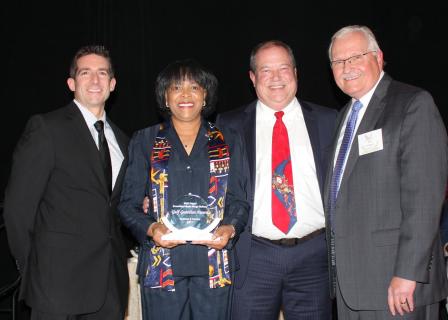 Pictured from left to right include: David Gatz, Environmental Senior Water Advisor at ExxonMobil; Del Dugas, American Project Development Group Business Planner at ExxonMobil; Robert Bert, State Regulatory Advisor at ExxonMobil; Bill Honker, EPA Region 6 Water Division Director.
Pictured from left to right include: David Gatz, Environmental Senior Water Advisor at ExxonMobil; Del Dugas, American Project Development Group Business Planner at ExxonMobil; Robert Bert, State Regulatory Advisor at ExxonMobil; Bill Honker, EPA Region 6 Water Division Director.
BIOX Project
ExxonMobil Baton Rouge Refinery
Baton Rouge, Louisiana
https://youtu.be/_vsSYTAl0sk
ExxonMobil Baton Rouge Refinery built new, innovative wastewater treatment tanks specifically designed to reduce the amount of nitrogen pollution in the wastewater, a multi-million-dollar investment. The innovative tank-in-tank design allows for two separate zones of biological treatment, one without oxygen and one with oxygen. These two separate zones allow for greater reduction of nitrogen in the wastewater and overall improved wastewater treatment. Since starting the new system in July 2014, the refinery has reduced nitrogen by over 85 percent, as well as decreased solids and biochemical oxygen demand emissions.
2nd Place Youth Environmental Education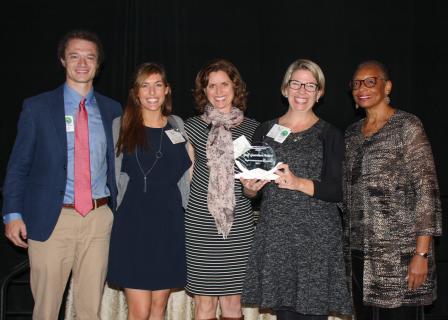 Pictured from left to right include: Cade Kistler, Program Director at Mobile Baykeeper; Laura Jackson, Program & Grants Coordinator at Mobile Baykeeper; Jamie Bullock, Education & Outreach Coordinator at Mobile Baykeeper; Casi Callaway, Executive Director at Mobile Baykeeper; Anne Heard, EPA Region 4 Deputy Regional Administrator.
Pictured from left to right include: Cade Kistler, Program Director at Mobile Baykeeper; Laura Jackson, Program & Grants Coordinator at Mobile Baykeeper; Jamie Bullock, Education & Outreach Coordinator at Mobile Baykeeper; Casi Callaway, Executive Director at Mobile Baykeeper; Anne Heard, EPA Region 4 Deputy Regional Administrator.
Strategic Watershed Awareness and Monitoring Program (SWAMP)
Mobile Baykeeper
Mobile, Alabama
https://youtu.be/fJMN-K19Rhc
The Strategic Watershed Awareness and Monitoring Program (SWAMP) is an education and monitoring program designed to broaden the understanding of watersheds, water quality, and how citizens impact the two. Mobile Baykeeper personnel educate high school students on watersheds and enlist students to receive training to monitor specific, local waterways. Through participation in SWAMP, students have the opportunity to investigate a water quality or pollution problem and develop a solution that can make a difference for their quality of life, local economy and natural resources.
2nd Place Environmental Justice/Cultural Diversity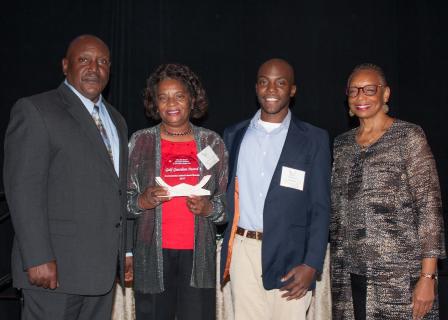 Pictured from left to right include: James Franklin, CEO at 34th Street Wholistic Gardens and Education Center; Aster Hawthorne, CFO at 34th Street Wholistic Gardens and Education Center; Andreas Franklin, Volunteer at 34th Street Wholistic Gardens and Education Center; Anne Heard, EPA Region 4 Deputy Regional Administrator.
Pictured from left to right include: James Franklin, CEO at 34th Street Wholistic Gardens and Education Center; Aster Hawthorne, CFO at 34th Street Wholistic Gardens and Education Center; Andreas Franklin, Volunteer at 34th Street Wholistic Gardens and Education Center; Anne Heard, EPA Region 4 Deputy Regional Administrator.
The 34th Street Wholistic Gardens & Education Center, Inc.
Gulfport, Mississippi
https://youtu.be/THEsXfzcg2w
The 34th Street Gardens and Education Center (the Gardens) is a purposefully designed organic and hydroponic garden model and wellness park that allows people of all age groups and cultures to grow healthy foods and participate in activities that promote health, wellness and good stewardship of the Mississippi Gulf Coast Region. The Gardens was established in April of 2016 to address food deserts and food insecurities and promote environmental education among the vulnerable communities in the region. To date, the Gardens has recruited over 25 volunteer master gardeners, and provides workshops, training and seminars that promote health, wellness, gardening and environmental education.
2nd Place Civic/Non-Profit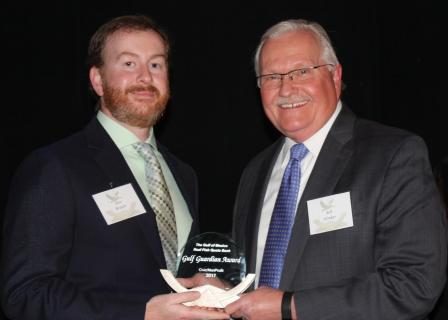 Pictured from left to right include: Eric Brazer, Deputy Director, Gulf of Mexico Reef Fish Shareholder’s Alliance; Bill Honker, EPA Region 6 Water Division Director.
Pictured from left to right include: Eric Brazer, Deputy Director, Gulf of Mexico Reef Fish Shareholder’s Alliance; Bill Honker, EPA Region 6 Water Division Director.
The Gulf of Mexico Reef Fish Quota Bank
The Gulf of Mexico Reef Fish Shareholders’ Alliance
Galveston, Texas
https://youtu.be/cClszMblMnM
The Gulf of Mexico Reef Fish Shareholders’ Alliance launched the Quota Bank in 2015 in response to growing concerns about wasteful discarding of red snapper in the Gulf’s grouper fishery and transitioning this successful fishery into the hands of the next generation of fishermen. The Quota Bank is an organization of forward-thinking fishermen coming together to help solve the problem of red snapper discards in the grouper fishery and assist the next generation of fishermen become established. It is the first fishermen-run community quota program in the Gulf of Mexico. In less than two years, the Quota Bank has worked with 20 fishermen in 15 fishing communities to salvage over 50,000 pounds of red snapper from being wastefully discarded, generated over $150,000 in revenue for these businesses and assisted two young commercial fishermen to help them build stronger business plans.
2nd Place Individual Pictured from left to right include: Sharon Gincauskas, Director, Ocean Hour, Inc.; Anne Heard, EPA Region 4 Deputy Regional Administrator.
Pictured from left to right include: Sharon Gincauskas, Director, Ocean Hour, Inc.; Anne Heard, EPA Region 4 Deputy Regional Administrator.
Sharon Gincauskas
Ocean Hour, Inc.
Pensacola, Florida
https://youtu.be/3Kzp9On8WTI
Sharon Gincauskas has single-handedly created a sustainable weekly beach clean-up involving volunteers spanning the entire Pensacola, Gulf Breeze and Pensacola Beach communities. Each Saturday morning, year round, Sharon presides over a one-hour shore clean up, directing the volunteers, providing the supplies and at the end of the hour processing the collected marine debris and disposing of the trash. Sharon’s efforts began four years ago when she went out to clean up by herself. Sharon’s hard work and accomplishments can be measured in the tons of marine debris removed from northwest Florida’s shores and watersheds, over two tons of trash thus far in 2016 alone.
2nd Place Bi-National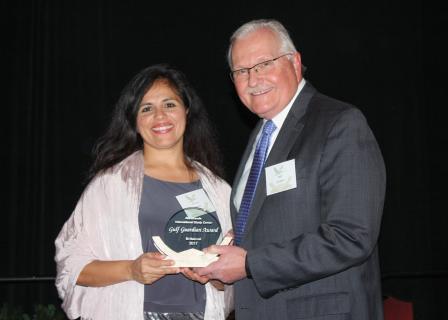 Pictured from left to right include: Tricia Cortez, Executive Director, Rio Grande International Study Center; Bill Honker, EPA Region 6 Water Division Director.
Pictured from left to right include: Tricia Cortez, Executive Director, Rio Grande International Study Center; Bill Honker, EPA Region 6 Water Division Director.
Rio Grande International Study Center
Laredo, Texas
https://youtu.be/rE8rMB3aHdY
RGISC’s mission is to preserve and protect the Rio Grande-Rio Bravo, its watershed and environment, through awareness, advocacy, research, education, stewardship and bi-national collaboration for the benefit of present and future generations.
Launched in 2010, RGISC’s Rio Research Roundup (RRR) is a binational water testing project that brings greater environmental awareness about the health of several river basins that drain into the Gulf of Mexico. Each October, nearly 3,000 students and teachers from 90 U.S. and Mexico teams take a field trip and sample water from the Rio Grande or related tributary, to provide a compelling snapshot of the river basin’s health.
2nd Place Partnerships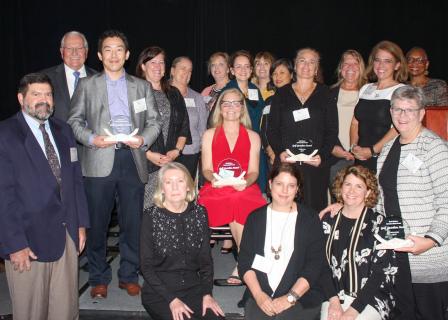
Gulf Citizen Science Data Portal
Gulf of Mexico Coastal Ocean Observing System
College Station, Texas
https://youtu.be/DkgbqGHPIYI
Pictured from left to right include: Bottom row: John O’Connell, Extension Agent at Texas Sea Grant; Margaret Sedlecky, Senior Educator at Weeks Bay National Estuarine Research Reserve; Rusty Low, Climate Scientist at the Institute for Global Environmental Strategies; Angela Sallis, Outreach Coordinator at National Oceanic Atmospheric Administration; Barb Kirkpatrick, Executive Director at Gulf of Mexico Coastal Ocean Observing System Middle row: Shin Kobara, Research Associate at Texas A & M University; Dana Pounds, Executive Director at Nature’s Academy; Chris Simoniello, Research Scientist at Texas A & M University; Charlene Mauro, Teacher at Navarre High School Back row: Bill Honker, EPA Region 6 Water Division Director; Debbi Stone, Director of Education at The Florida Aquarium; Dianne Lindstedt, Extension Agent at Louisiana Sea Grant; Tricia LeBlanc, Director of Education Programs at the Audubon Nature Institute; Lee Yokel, Education and Engagement Team Coordinator at Gulf of Mexico Alliance; Ruth Perry, Marine Scientist and Regulatory Policy Specialist at Shell Exploration and Production Company; Lei Hu, Senior Marine Scientist at Dauphin Island Sea Lab; Chris Verlinde, Extension Agent at Florida Sea Grant; Anne Heard, EPA Region 4 Regional Deputy Administrator.
The Gulf of Mexico Coastal Ocean Observing System’s (GCOOS) Gulf Citizen Science Portal encourages a widespread, diverse Gulf community to contribute knowledge and data about the Gulf. The backbone of the citizen monitoring network is comprised of retired citizens and many students from underserved and underrepresented communities. The portal was developed and implemented as a cost-effective way to gather local information over long periods of time, allowing state, federal and academic programs to supplement datasets with important detail.
Third Place Gulf Guardian Winners
3rd Place Civic/Non-Profit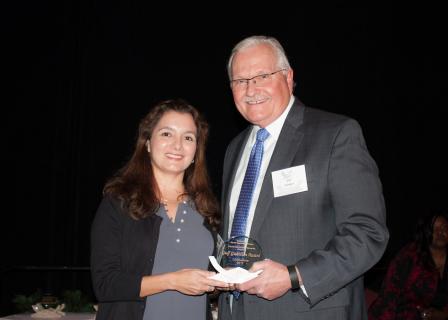 Pictured from left to right include: Marissa Llosa, Extension Program Specialist, Texas A&M AgriLife Extension Service; Bill Honker, EPA Region 6 Water Division Director.
Pictured from left to right include: Marissa Llosa, Extension Program Specialist, Texas A&M AgriLife Extension Service; Bill Honker, EPA Region 6 Water Division Director.
Sheldon Lake State Park Wetland Restoration Partnership
Texas A&M AgriLife Extension Service
Houston, Texas
https://youtu.be/kq3Qc32kvL8
The Sheldon Lake State Park Wetland Restoration partnership has restored over 375 acres of critical coastal prairie wetland habitat at Sheldon Lake State Park in the last 13 years. Investing over 10,500 hours since 2003, the volunteers have been a fundamental component of the restoration. Similarly, student involvement (representing over 3500 hours) has been equally critical for the project and the students themselves, increasing their stewardship role in “their” park. The long-term success of the restoration has been further validated with recent funding to complete the fifth phase of restoration with an additional 62 acres.
3rd Place Individual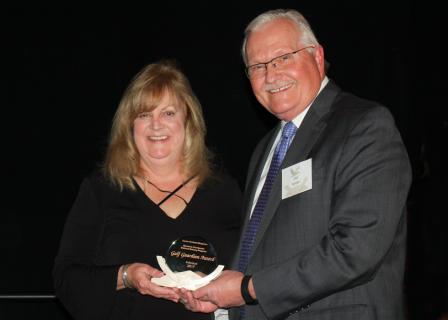 Pictured from left to right include: Susan Testroet-Bergeron, Director, Barataria-Terrebonne National Estuary Program; Bill Honker, EPA Region 6 Water Division Director.
Pictured from left to right include: Susan Testroet-Bergeron, Director, Barataria-Terrebonne National Estuary Program; Bill Honker, EPA Region 6 Water Division Director.
Susan Testroet-Bergeron
Barataria-Terrebonne National Estuary Program
Thibodaux, Louisiana
https://youtu.be/4Ea0C89b-R8
After the tragedies of Hurricane Katrina and the Gulf oil spill, Susan realized the best education of our culture, environment and fragile land comes from the people who live here. She worked to tell their stories by curating an exhibit for the Coastal Wetlands Planning, Protection and Restoration Act’s called “I Remember,” which features oral histories, photographs and original art depicting individuals who work, live, and play in Louisiana's coastal wetlands.
Susan Testroet-Bergeron accepted the position of Program Director of the Barataria-Terrebonne National Estuary Program (BTNEP) in January of 2015. Susan’s organizational and partnership skills have made her the perfect leader to implement BTNEP’s Comprehensive Conservation and Management Plan. Her greatest contribution to the Gulf Coast has been her untiring fight for environmental education.
3rd Place Partnerships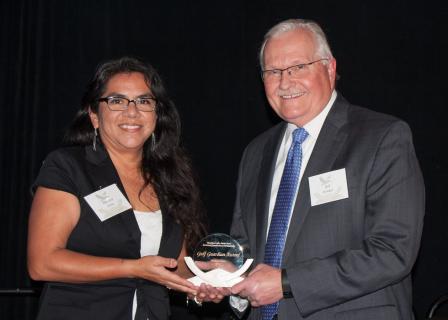 Pictured from left to right include: Rosario Martinez, Senior Project Manager, Coastal Bend Bays & Estuaries Program; Bill Honker, Region 6 Water Division Director.
Pictured from left to right include: Rosario Martinez, Senior Project Manager, Coastal Bend Bays & Estuaries Program; Bill Honker, Region 6 Water Division Director.
Nueces Bay Marsh Restoration Project
Coastal Bend Bays & Estuaries Program
Corpus Christi, Texas
https://youtu.be/UbywIP64qdU
The Nueces Bay Marsh is a 160-acre marsh restoration project along the Nueces Bay Causeway between Corpus Christi, Texas, and Portland, Texas. The marsh began to decline in the 1940’s when construction began on the Highway 181 Nueces Bay Causeway. The construction and related dredging lasted almost 15 years and resulted in the loss of about 180 acres of highly productive marsh. In the years that followed, an additional 160 acres of marsh was lost due to erosion and subsidence. The loss not only harmed the fish and wildlife in the marsh, but it threatened the Highway 181 corridor and associated infrastructure.
